Smartphones and tablets have replaced Nintendo as the entry point for gaming for the youngest players, according to a survey by the Magid Games Team.
Players are also starting out playing games at younger ages. About 29% of those under three years old are playing games. And by the time they’re seven, they’re playing games as much as older age groups.
Those are interesting findings from the research company and game developers and publishers should think about them as they try to win over the next generation of players.
The in-depth study, known as Knowledge Core, leans into industry-wide questions that will have a critical impact the future of gaming. This year’s Knowledge Core, Generation Next, highlights younger gamers and how they might evolve over the next three to five years. It’s important to understand this generation now as it can take three to five years to make games for these players, said Monika Madrid, vice president of business development at Magid Games, in an interview with GamesBeat.
In this report, Magid did both quantitative and qualitative research, going into homes and talking to both kids and parents. They spoke to about 1,500 people from 10 years old to 44 years old, said Josh Fortey, vice president of quantitative for games at Magid.
“This year, it was really about Generation Next, which means the pandemic really kind of changed the way people consume games, and media and everything in general, because of how they grew up,” said Mike Salmon, senior vice president of games at Magid, in an interview. “We want to understand these people today who 10 to 17 years are old. What are they doing tomorrow?”
Smartphones are the entry point for gaming
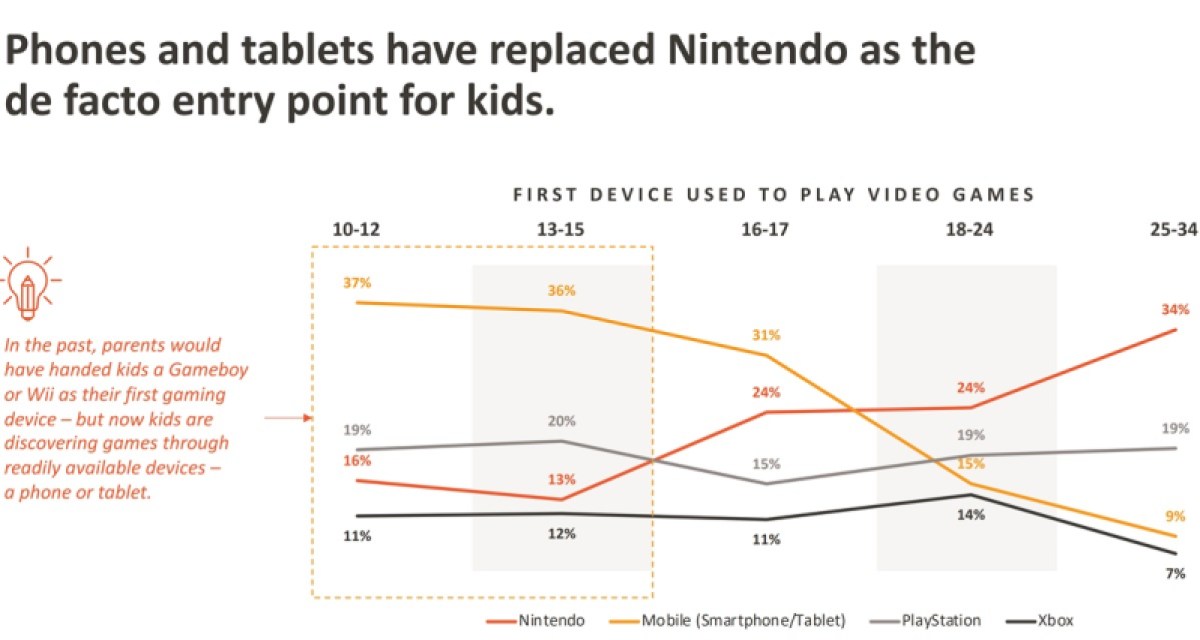
As successful as the Nintendo Switch has been, Magid found something interesting about today’s kids. The smartphone and tablet have become the primary device that introduces kids to gaming, rather than Nintendo’s devices, said Fortey.
Over time, the devices change as teens get into consoles or older games return to Nintendo as their primary devices. But it’s a pretty big shift considering Nintendo’s hold on the young throughout history.
“It makes sense that Nintendo has lost ground to smartphones and tablets because it shares a pretty similar positioning as to why people get into games — and that is convenience,” said Fortey. “You’ll see that those who choose Nintendo as their primary device and those who choose mobile as their primary device, it’s because it is the easiest and quickest to pick up.”
The 29% figure about so many kids three and under playing is a big uptick in activity, Salmon said. The pandemic is part of the reason for that.
Fortey said, “It starts to ramp up pretty early on in life, with 29% of those ages zero to three playing. I have a four-year-old and she plays a lot of a lot of games on her tablet. It just ramps up very quickly. By the time kids are about seven years old, it’s almost at parity with the incidence of people who are playing games at older ages. So around that 80% mark of people who are playing video games.”
Gaming remains the No. 1 activity until the gamer hits 18. Then things like music or video streaming become contenders for their time, Fortey said. Sony’s PlayStation gets a big share of gamers because its games are so good and it has a perceived performance advantage, while Xbox is gaining people because of the power of the Xbox Game Pass subscription.
Inter-generational games
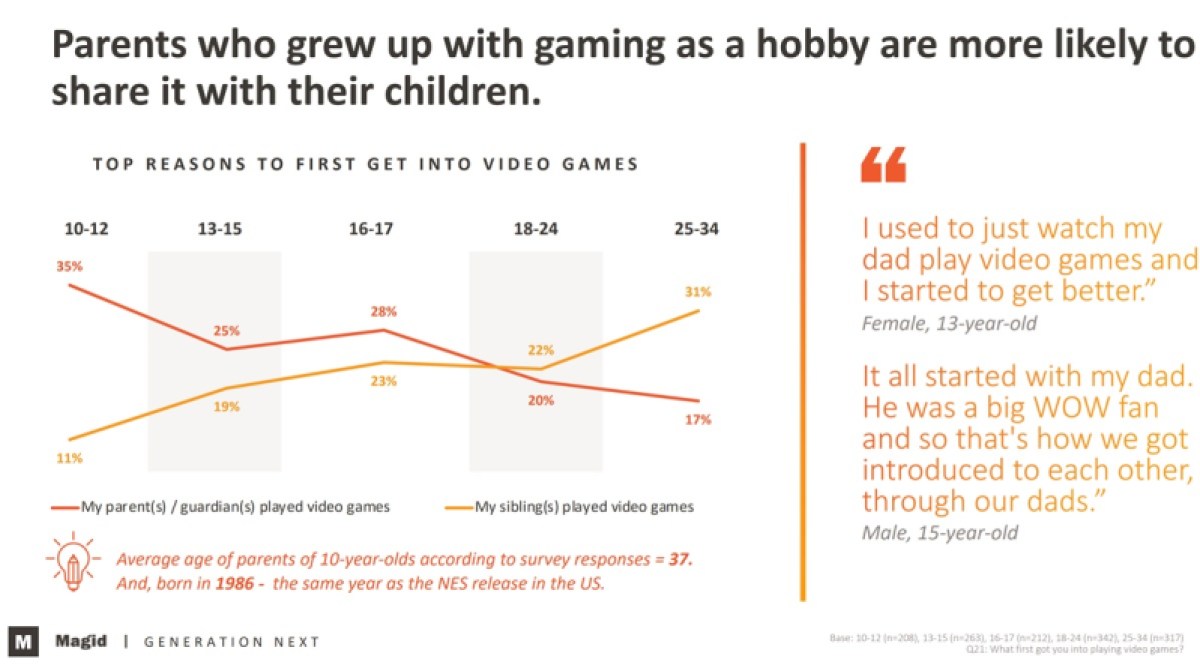
Jason Rice, vice president of qualitative for games at Magid, said in an interview that the role of parents is changing as inter-generational gaming takes root. Older gamers lose some of the skills they need to keep playing, and that contributes to some fall off over time.
Many young folks said that their siblings got them into video games. But now that pattern has been replaced by parents. With inter-generational gamers, parents are introducing gaming culture to the family. Even non-gaming parents get into the act by playing with their kids. It’s like the whole family watches Disney or Marvel shows on television.
Madrid noted that it’s hard for marketers to reach kids. But there is still the opportunity to market to the parents and have them pass down the interest to the children. The current generation of older gamers have parents who don’t understand games. But not so for the inter-generational gaming families. The holidays in particular are ideal for kids to play with parents and for everyone to take a turn.
The social era
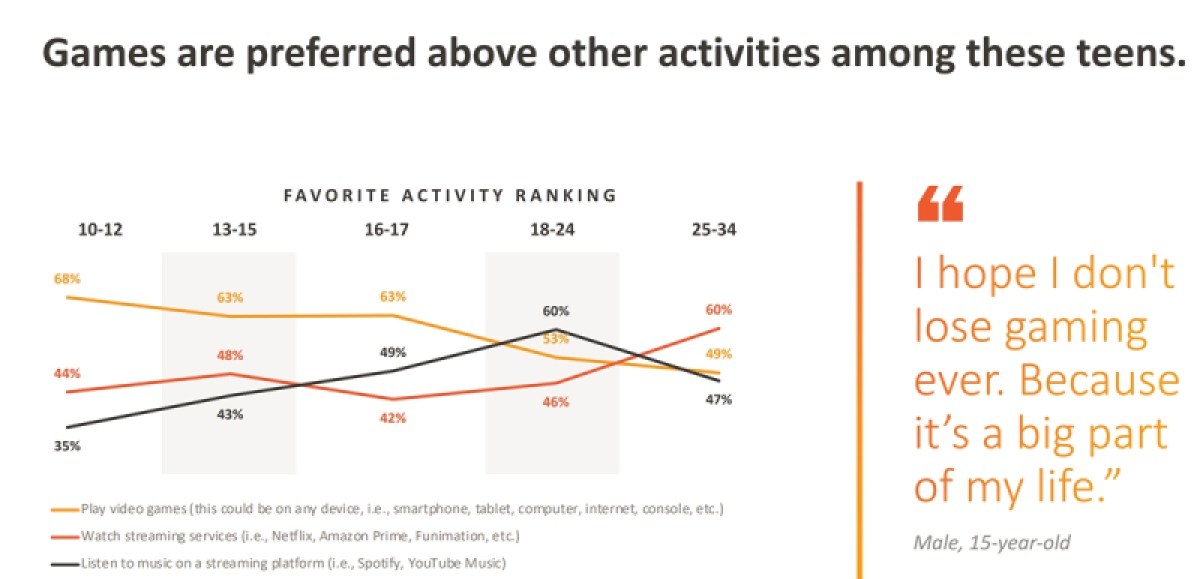
Socialization is a key part of how teens develop. But how they socialize has evolved with technology. With games at the center of how kids socialize, walled gardens are no longer tenable.
Young folks definitely expect that everyone should be able to play, and so crossplay is becoming critical to ensuring frictionless social experiences.
“Cross play is huge,” said Rice. “You don’t want to necessarily have these walls put up between them based on platform choice. It speaks to the popularity of games like Roblox, Minecraft and Fortnite. You can play them across any platform. Changing the dynamic group size is important.”
You can adjust the size of the group from two players on a team to four or five, as needed.
Not all gaming is experienced with existing social relationships, and solo play is still popular. Playing alone doesn’t have to be lonely. It can be a way to carve out your own identity via the media you consume. Things like speedrunning competitions can make single-player games more social.
The use of TikTok and other social platforms for game discovery is huge with this generation, but less so for older game consumers. Social play has always been important, but it is required for the new generation. And bite sized content has an out-sized impact on younger ages.
“YouTube is high but TikTok is climbing up there and making a big imprint on how people think and learn about games,” Rice said. “The gap is narrower than we’ve ever seen.”
Video is omnipresent in how kids and adults discover games. Streamers have influence on children as young as 10. Short-form video is an increasingly potent tool for capturing kids’ attention in the formats they desire. Short funny clips are very popular.
And social media can influence across age spectrums. It can be as influential for those 25 and older as it is for those ages 13 to 17.
User-generated content
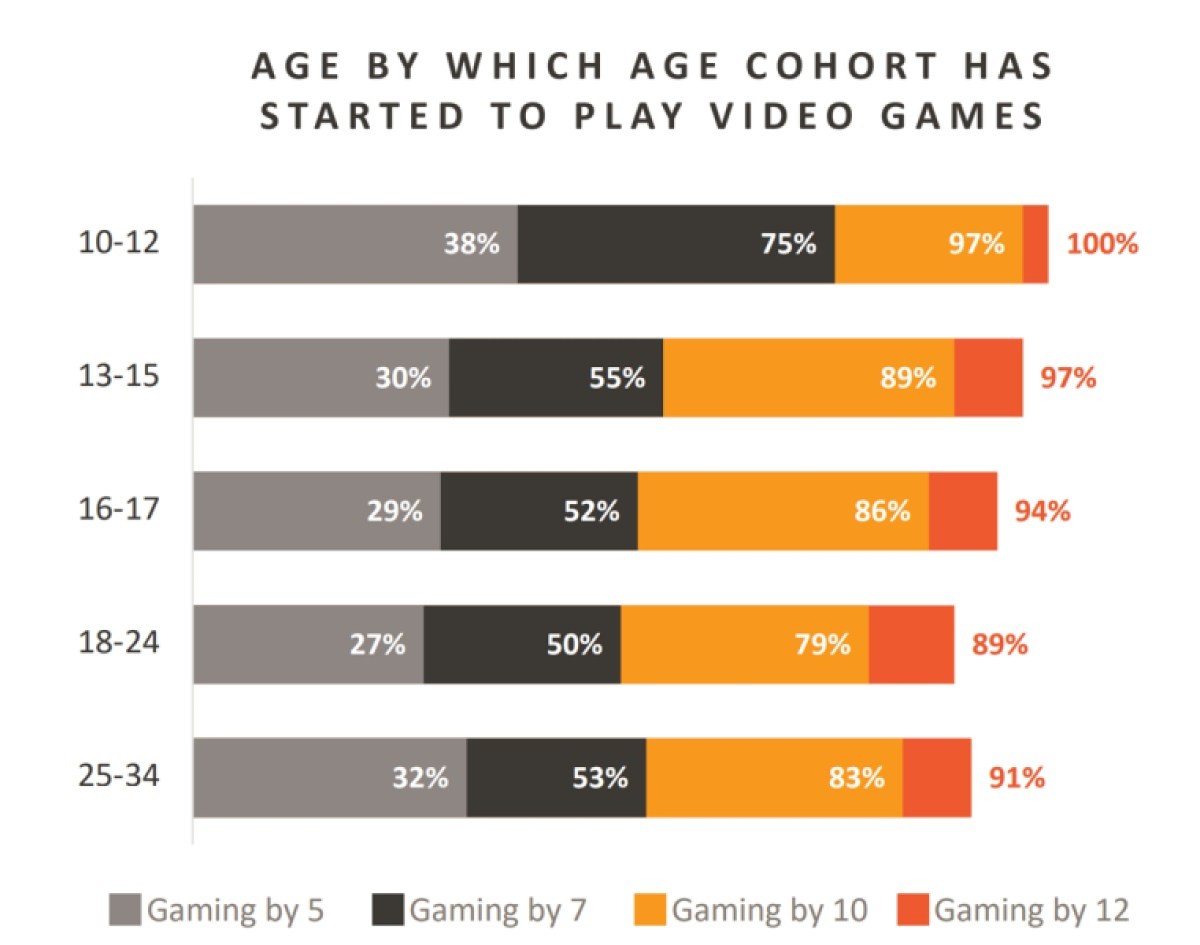
As kids age, their emotional needs evolve and the games they play reflect that. User-generated content and creation is endemic to this generation and will likely affect how and what they play moving forward. Establishing identity among their peers is a large part of what makes social gaming important to these gamers.
Fortey said you see a steep decline in Roblox once people reach 25, which is not surprising giving Roblox’s roots among younger kids. The platform is trying to age up, but it seems like Minecraft is more successful in this respect.
Roblox may lose steam as the primary game in favor of high-fidelity experiences as kids age. UGC is rapidly becoming a bigger part of a teen’s experience of playing games. Many kids want to be able to create video games on platforms like Roblox. It’s fun to be part of a creative community. Players want to make their own imprint on the game and make it into their own creation. It’s not just a passive experience, Rice said.
Free to play makes the most sense for the younger players, but they are open to premium games and battle passes. But they don’t like predatory monetization practices.
“The question is are the publishers ready? You have a whole generation of people who are creators who are really interested in easy access tools for UGC, whether that’s AI or something integrated into a game. It’s a big challenge for publishers. It’s an unknown and it’s expensive,” Madrid said. “The whole point is how to get people thinking about what to deliver in three to five years because you have to start creating that now.”
Toxicity problems
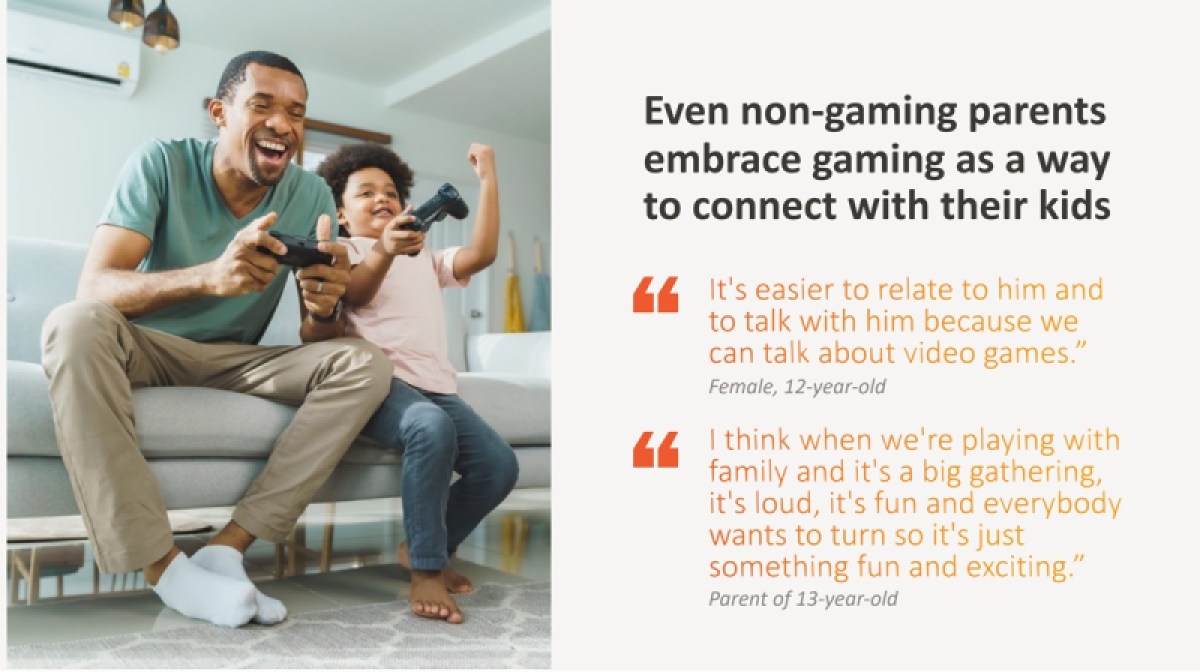
Toxicity is a real problem, and it drives people away from games. This generation feels confident they can handle that toxicity. Parents are more likely to loosen the leash as their kids become teens, trusting them to manage their online presence.
Most gamers view gaming as a good thing, though small groups view it as doing harm. Toxicity can have a big impact on player churn, especially among youths. Parents and kids want to be confident in their ability to deal with toxicity.
“And it’s especially different for females than it is for males. Males will tend to stay around a lot longer in a game universe of random people, while females or other people who could be in that toxicity,” Salmon said.
People and generations can change
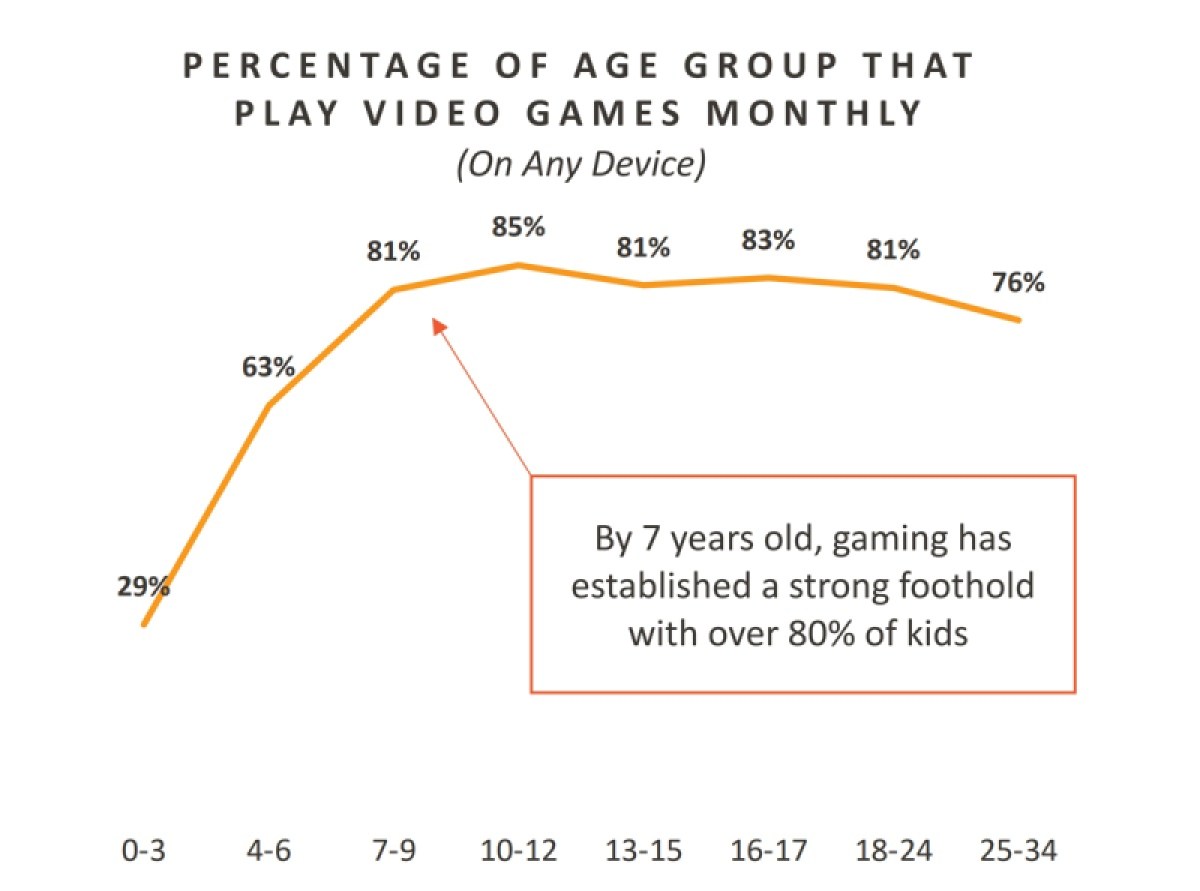
Overall, what’s interesting about the survey is that people can change over time, and circumstances are different for each generation.
COVID changed a lot of behaviors for kids. But one of the key questions is whether these behaviors persist as the pandemic fades from memory, Rice said.
“How many of these behaviors persist and how many of these behaviors fade out?” Rice said. “Playing a game is a way to maintain their social relationships.”
Rice said that COVID accelerated the social role of games as people played during lockdown to maintain their social relationships with those they couldn’t see. Multiple kids talked about the ways in which they use Minecraft as a platform to have social interactions with their friends when something challenging was going on. It was a way to talk about difficult topics without having to be together in person, Rice said.
“It’s like how older men are having a hard time making friends and one of the things they recommend is go to the gym,” Fortey said. “You can talk about serious emotional topics at the gym without having to look at each other in the eye because that always makes it more difficult. And kids are already doing this with video games.”
I can relate to that as I played a lot of Call of Duty: Warzone with friends during the pandemic, when we couldn’t talk in other ways.
GamesBeat’s creed when covering the game industry is “where passion meets business.” What does this mean? We want to tell you how the news matters to you — not just as a decision-maker at a game studio, but also as a fan of games. Whether you read our articles, listen to our podcasts, or watch our videos, GamesBeat will help you learn about the industry and enjoy engaging with it. Discover our Briefings.

